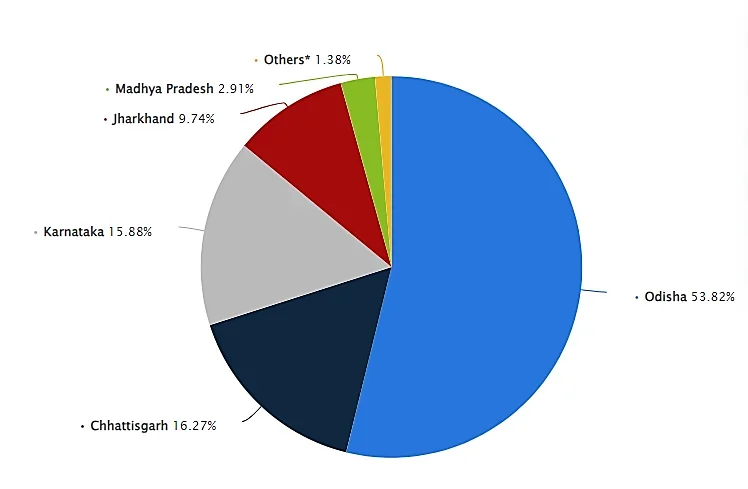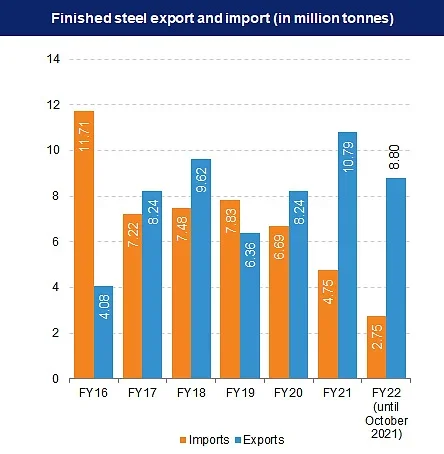The Competition Commission of India (CCI) recently conducted a market study focusing on the mining sector, particularly iron ore, to assess competition dynamics and market fairness.
About the study:
- The study addressed concerns related to differential pricing, exports, and entry barriers in the iron ore and steel industry.
Key highlights of the study:
India’s Iron Ore Production Overview:
- India is self-sufficient in iron ore, contributing 7% to global production (4th largest globally).
- The value of iron ore exports has surpassed imports, showcasing increased competitiveness in value-added products like pellets.
- 95% of iron ore production is directed to the steel sector, emphasizing strong interlinkages between the 2 industries.
- Allocation of captive mines to specific players creates entry barriers, hindering new firms’ entry and operation due to high costs.
Competition Concerns and Pricing:
- Amendments in mining law (2021) by allowing captive mines to sell 50% surplus in the open market may boost iron ore supply.
- Caution is urged when captive mines sell surplus to other entities to prevent high costs for buyers competing in the steel market.
Key recommendations of the study:
- To address iron ore availability, e-auctions must be held weekly or bi-weekly, aligning with business needs for enhanced efficiency.
- Government must emphasis on sustainable mining by gradually phasing out ‘dirty’ technologies.
- A clear regulatory framework to incentivize the adoption of clean technology must be framed and facilitate the transformation of production processes towards sustainability.
- Discourage iron ore exports and encourage high value-added activities, including domestic steel production, to control prices effectively.
About the Distribution of Iron Ore in India:
Major Iron Ore Belts in India:
- Orissa-JharkhandBelt: This belt is the largest iron ore belt in India and covers the states of Orissa and Jharkhand.
- The important mines in this belt are Noamundi, Kiriburu, and Badampahar mines.
- Durg-Bastar-Chandrapur Belt: This belt lies in Chhattisgarh and Maharashtra.
- The important mines in this belt are Bailadila iron ore deposit and Dalli-Rajhara.
- Bellary-Chitradurga-Chikmaglur-Tumkur Belt: This belt is located in Karnataka, with important mines in the region being Hospet, Sandur, and Bellary.
- Maharashtra-Goa Belt: This belt is situated in Goa and parts of Maharashtra, with important mines being Goa, Ratnagiri, and Sandur.
- Odisha-Jharkhand Belt: This belt spans across the states of Odisha and Jharkhand, with important mines being Gurumahisani, Sulaipat, and Badampahar.
Types of Iron ore in India:
- Magnetite: This is the best quality of iron ore containing 72% of pure iron.
- It possesses magnetic property and hence is called magnetite.
- It is found in Andhra Pradesh, Jharkhand, Goa, Kerala, Tamil Nadu and Karnataka.
- Haematite: It contains 60-70% pure iron and is found in Andhra Pradesh, Jharkhand, Orissa, Chhattisgarh, Goa, Karnataka, Maharashtra and Rajasthan.
- Limonite: It contains 40- 60% of pure iron and is of yellow or light brown colour.
- Siderite: It contains many impurities and has just 40-50% of pure iron.
- However, due to presence of lime, it is self-fluxing.
Major Iron Ore producing States:
- Odisha: Odisha is the largest producer of iron ore in India, which accounts for 53.8% of the country’s overall output.
About the Distribution of Steel in India:
- India is the world’s second-largest producer of the crude steel, but the distribution of steel production is not uniform across the country.
- The primary steel-producing states in India include Odisha, Jharkhand, Chhattisgarh, West Bengal, and Karnataka.
- Major steel plants are located in these states, contributing significantly to the overall production.
- Odisha is the largest producer of steel in India, with a capacity of 18 million tonnes per year of steel production.
- Jharkhand: It is home to steel plants like Tata Steel in Jamshedpur, Steel Authority of India Limited (SAIL) in Bokaro etc.
- Chhattisgarh: It is home to Bhilai Steel Plant (SAIL), and NMDC Steel Plant in Nagarnar.
- West Bengal: It has Durgapur Steel Plant, which is an important steel production facility in the region.
About Competition Commission of India (CCI)
- The Competition Commission of India (CCI) is a statutory body that aims to promote and sustain competition in the market, protect the interests of consumers, and ensure freedom of trade carried on by other participants in the market in India.
- It was established in 2003 under the Competition Act, 2002.
- The Competition Act, 2002, provides the legal framework for its functioning and defines anti-competitive practices.
- It helps to prevent anti-competitive practices and create a competitive environment in the country.
- The National Company Law Appellate Tribunal (NCLAT) hears appeals against the judgements given by CCI related to competition matters.
- It is a member of the International Competition Network (ICN) and actively participates in discussions on global competition issues.
Composition:
- The Commission consists of a Chairperson and not less than 2 and not more than 6 members appointed by the Central Government.
- The Chairperson and members are appointed based on their expertise in economics, business, law, or public affairs.
Functions:
- Investigating and penalizing anti-competitive agreements and abuse of dominant positions.
- Regulating combinations (mergers and acquisitions) that may have an adverse effect on competition.
- Advocating competition policy and creating awareness about competition issues.
Ref: Source
| UPSC IAS Preparation Resources | |
| Current Affairs Analysis | Topperspedia |
| GS Shots | Simply Explained |
| Daily Flash Cards | Daily Quiz |





